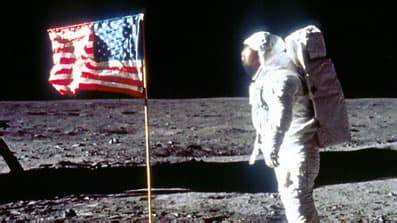Welcome to THE MAKING OF A NATION – American history in VOA Special English. I'm Steve Ember. On a cold October day in nineteen fifty-seven, the Soviet Union launched a small satellite into orbit around the Earth. Radio Moscow made the announcement. "The first artificial Earth satellite in the world has now been created. This first satellite was today successfully launched in the USSR." The world's first satellite was called Sputnik 1. Sputnik was an important propaganda victory for the Soviets in the Cold War with the United States. Many people believed the nation that controlled space could win any war. And the Soviet Union had reached outer space first.
The technology that launched Sputnik probably began in the late nineteenth century. A Russian teacher of that time, Konstantin Tsiolkovsky, decided that a rocket engine could provide power for a space vehicle. In the early nineteen hundreds, another teacher -- American Robert Goddard -- tested the idea. He experimented with small rockets to see how high and how far they could travel. In nineteen twenty-three, a Romanian student in Germany, Hermann Oberth, showed how a spaceship might be built and launched to other planets. Rocket technology improved during World War Two. It was used to produce flying bombs. Thousands of people in Britain and Belgium died as a result of V-1 and V-2 rocket attacks. The rockets were launched from Germany. The larger V-2 rocket had the ability to hit the United States. After the war, it became clear that the United States and the Soviet Union -- allies in wartime -- would become enemies in peacetime. So, both countries employed German scientists to help them win the race to space. The Soviets took the first step by creating Sputnik.

This satellite was about the size of a basketball. It got its power from a rocket. It orbited Earth for three months. Within weeks, the Soviets launched another satellite into Earth orbit, Sputnik 2. It was much bigger and heavier than Sputnik 1. It also carried a passenger: a dog named Laika. Laika orbited the earth for seven days. The United States joined the space race about three months later. It launched a satellite from Cape Canaveral, in the southeastern state of Florida. This satellite was called Explorer 1. It weighed about fourteen kilograms. Explorer 1 went into a higher orbit than either Sputnik. And its instruments made an important discovery. They found an area of radiation about nine hundred sixty kilometers above Earth. The next major space victory belonged to the Soviets. They sent the first man into space. In April, nineteen sixty-one, cosmonaut Yuri Gagarin was launched in the vehicle known as Vostok. He remained in space for less than two hours. He landed safely by parachute near a village in Russia.
Less than a month later, the United States sent its first astronaut into space. He was Alan Shepard. Shepard remained in space only about fifteen minutes. He did not go into Earth orbit. That flight came in February, nineteen sixty-two, with John Glenn. By nineteen sixty-five, the United States and the Soviet Union were experimenting to see if humans could survive outside a spacecraft. In March, Russian cosmonaut Alexei Leonov became the first person to do so. A strong tether connected Leonov to the spacecraft. The tether gave him oxygen to breathe. And it permitted him to float freely at the other end. After about ten minutes, Leonov had to return to the spacecraft. He said he regretted the decision. He was having such a good time! A little more than two months later, an American would walk outside his spacecraft. Astronaut Edward White had a kind of rocket gun. This gave him some control of his movements in space. Like Leonov, White was sorry when he had to return to his spacecraft. Later that year, nineteen sixty-five, the United States tried to have one spacecraft get very close to another spacecraft while in orbit. This was the first step in getting spacecraft to link, or dock, together. Docking would be necessary to land men on the moon. The plan called for a Gemini spacecraft carrying two astronauts to get close to an unmanned satellite.












